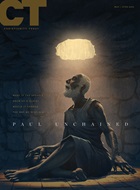The Light of the World Became Flesh
When Jesus spoke again to the people, he said, “I am the light of the world. Whoever follows me will never walk in darkness, but will have the light of life.” Jn 8:12
I recently began to read a new book, The Liturgy of Creation by Michael LeFebvre. The central premise of this book is that we will best understand Genesis 1 when we first understand how calendars work in the Old and New Testament. Michael LeFebvre is a pastor (and an adjunct professor of Old Testament). C. John Collins provides a forward for the book while Old Testament Scholars John Walton, Tremper Longman III, and Ken Turner provide “blurbs” for the book. The purpose of the book is not to reconcile science with Genesis, but to understand how the biblical authors used the calendar to convey a memorable message.
Appropriate for the day, the Pentateuch uses dates in a manner that conflicts with modern sensibilities.
This method of assigning dates would be like telling the Christmas story and stating that “Mary laid her baby in a manger on the twenty-fifth day of the twelfth month.” That was not the date on which Jesus was actually born, but the date would associate memory with the timing of its actual observance (December 25). For certain, modern historical conventions would regard such a saying as inaccurate, hence the sentiment of many scholars that either the Synoptics or John must be “inaccurate” when giving contradictory dates for the crucifixion. But the problem lies not in inaccurate texts, but rather our anachronistic expectations for the purpose for an author’s giving a date to an event. (p. 61)
LeFebvre notes that John places the crucifixion on the day when the lambs are sacrificed for the Passover meal while the Synoptics place the crucifixion on the day following the Passover meal. Efforts to harmonize these two accounts miss the point that is being made in the telling of the story. Although our date for celebrating Christmas at the winter solstice (essentially) is not biblical, it does carry meaning. In a footnote LeFebvre quotes from Augustine:
The actual date of Jesus’ birth is not known. December 25th was adopted to align commemoration of his birth with the winter solstice, the date when night is at its longest and from whence the days begin to overtake the night in length. Augustine preached, “Hence it is that He was born on the day which is shortest in our earthly reckoning and from which subsequent days begin to increase in length. He, therefore, who bent low and lifted us up chose the shortest day, yet the one whence light begins to increase.” (p. 61 – “For the Feast of Nativity” in Sermons on the Liturgical Seasons. p. 34″)
The symbolism is significant whether the day is accurate or not (and it is highly unlikely that it is accurate given the shepherds in the field). It also doesn’t matter that the European winter solstice is not the shortest day in the southern hemisphere. Irrespective of the historical calendar, we celebrate the incarnation when the light of the world became human. In the northern hemisphere at least, the winter solstice gives us insight into what this means.
If you wish to contact me directly you may do so at rjs4mail[at]att.net.
If interested you can subscribe to a full text feed of my posts at Musings on Science and Theology.
We will dig into more of LeFebvre’s book over the coming months. Join us if you’d like.
(The links above are paid referrals – try this one if you prefer: The Liturgy of Creation.)
Jesus Creed is a part of CT's
Blog Forum. Support the work of CT.
Subscribe and get one year free.
The views of the blogger do not necessarily reflect those of Christianity Today.


















